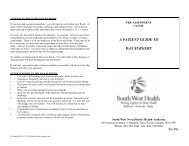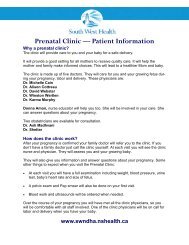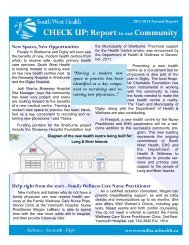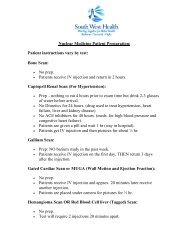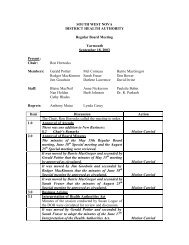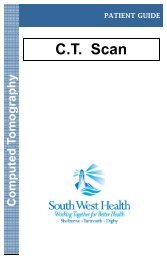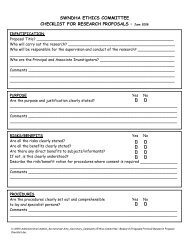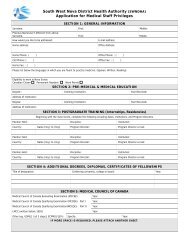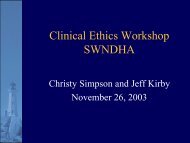Breastfeeding basics Breastfeeding basics - South West Health
Breastfeeding basics Breastfeeding basics - South West Health
Breastfeeding basics Breastfeeding basics - South West Health
Create successful ePaper yourself
Turn your PDF publications into a flip-book with our unique Google optimized e-Paper software.
56 B REASTFEEDING B ASICS T O S IX M ONTHS AND B EYOND 57<br />
Combine breastfeeding with another<br />
feeding choice<br />
You can breastfeed when you are with your<br />
child and use another form of milk when you<br />
are not. If you choose this option, then start<br />
replacing breastfeedings a week or two before<br />
you go to work or school. Replace one<br />
breastfeeding every three to seven days. This<br />
gives your breasts a chance to adjust to the<br />
lower demand. Otherwise, your breasts will<br />
become engorged while you are away from your<br />
baby.<br />
Consider your baby’s age before choosing this<br />
option. Your baby is less likely to develop food<br />
allergies if fed only breastmilk for at least the<br />
first four months of life. If family members are<br />
prone to allergies, then delay solid foods and<br />
other forms of milk until your baby is six<br />
months. For more information on introducing<br />
iother forms of milk, see Year One: Food for Baby<br />
(see page 90).<br />
“Jacob was nine months old when I went back to work.<br />
For the first couple of months, my husband was able to stay<br />
home with him. I would skip my coffee break and go home<br />
for lunch to breastfeed him. When he was eleven months<br />
old, he went to a day home. For the first month of this new<br />
arrangement, I continued to breastfeed him at lunchtime.<br />
This made the change of routine easier for us both. My boss<br />
was great about it. He was a new dad.” a nursing mother<br />
iBaby teeth and<br />
breastfeeding<br />
Preventing tooth decay<br />
Breastfed children are less likely to have tooth<br />
decay than bottlefed children. However, it is<br />
still something to guard against.<br />
Dental decay happens when sugar is left on the<br />
teeth. Breastmilk contains sugar, as does juice,<br />
cow’s milk, and formula. Germs on the teeth<br />
use the sugar to make acid. This acid dissolves<br />
tooth enamel. At night, tooth decay happens<br />
more quickly because there is less saliva to wash<br />
away the acid.<br />
You can prevent tooth decay by starting mouth<br />
care early:<br />
• Clean the inside of baby’s mouth using<br />
a clean, damp facecloth each day.<br />
• Once the first tooth appears, brush twice a<br />
day. Use a small, soft-bristled toothbrush with<br />
less than a pea-sized amount of toothpaste.<br />
• Check your baby’s teeth often. If you notice<br />
white or brown spots, call your dentist right<br />
away.<br />
• Begin regular dental visits around age one.<br />
See Year One: Food for Baby for more<br />
information on oral health.


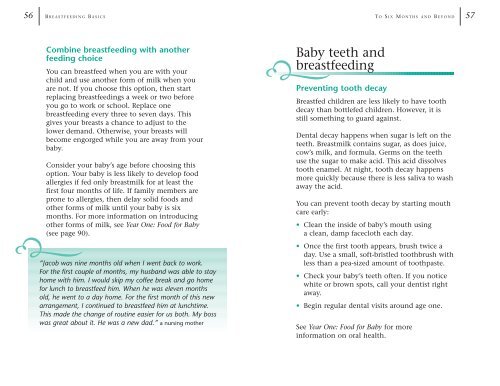
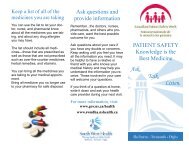


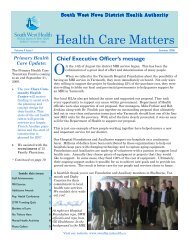
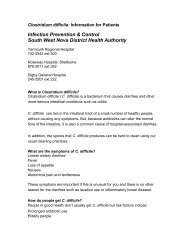
![Pressure Ulcer Prevention SWH[1].pub - South West Health](https://img.yumpu.com/26992883/1/190x115/pressure-ulcer-prevention-swh1pub-south-west-health.jpg?quality=85)
